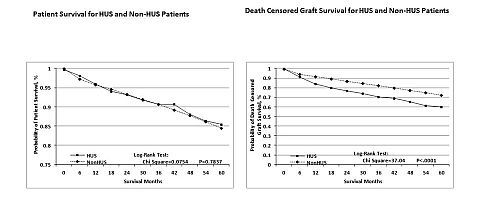Outcome of Kidney Transplants (KT) in U.S. Adult HUS Patients: A Ten Year Database Analysis
Univ of Florida, Gainesville, FL
Private Practice, W Melbourne, FL
Meeting: 2013 American Transplant Congress
Abstract number: 375
Purpose. Large population studies on the outcome of HUS KT recipients (HUS-KTR) are limited. We aimed to determine their patient and graft outcomes compared with non-HUS KTR (NHUS-KTR).
Methods. Based on SRTR, KT from 1/99 to 12/09 were studied. 2 groups were analyzed: HUS-KTR and NHUS-KTR. Donor, recipient,and transplant factors were compared. Main outcomes analyzed were patient and death censored graft survivals (DCGS).
Results. Out of 122,435 adult KTR from 1/99 to 12/09, CKD that led to KT was due to HUS in 323 (0.3%) and other causes in 122,112 (99.7%).
No significant differences in patient survival for HUSKTR and NHUSKTR at 12, 24, 36, 48 and, 60 mos. post KT were found. Survival probability at 12 mos. was 96 % and 85.4 % at 60 mos. for HUS-KTR compared with 95.8% and 84.4%, respectively for NHUS-KTR (logrank X 2.0754, p 0.7837). Multivariate modeling showed increased HR for death related to the following : Black, female, and older donors ; older recipient ; PRA >20% ;years of dialysis ;ECD / SCD kidneys ; DGF;AR ;and prolonged WIT. Patient survival was not different between KTR with HUS recurrence and those without (P 0.76). DCGS outcome was analyzed. Graft loss rate over 60 mos. was 0.4% /mo in HUS-KTR and 0.2 % /mo in NHUS-KTR. During the period studied, the DCGS was consistently lower for the HUS-KTR than the NHUS-KTR (87% vs 94.5 % ,12 mo. and 68.8 % vs 82.1 % ,60 mo.P < 0.0001.) AR rate after discharge was 17 % in HUS-KTR and 13 % in NHUS-KTR (p 0.0110). Graft failure rates between HUS KTR with and without HUS recurrence were compared. Throughout the period studied, graft survival was significantly lower for the HUS-recurrence group than the HUS-non recurrence group (49.0 vs. 89.2 % at 1 yr.; 14.7 % vs. 66.8 % at 5 yr.).
Conclusions: Over the 10 year period analyzed there was no significant difference in patient survival between HUS-KTR and NHUS-KTR. However, DCGS was significantly lower,and the rate of graft loss was higher for HUS-KTR vs. NHUS-KTR 5 years after KT. Rejection rate after discharge was higher for HUS-KTR. Graft outcome was worse for recurrent HUS after KT.

To cite this abstract in AMA style:
Santos A, Faldu C, Wen X, Casey M, Bucci C, Aiyer R, Zendejas I, Rehman S. Outcome of Kidney Transplants (KT) in U.S. Adult HUS Patients: A Ten Year Database Analysis [abstract]. Am J Transplant. 2013; 13 (suppl 5). https://atcmeetingabstracts.com/abstract/outcome-of-kidney-transplants-kt-in-u-s-adult-hus-patients-a-ten-year-database-analysis/. Accessed December 9, 2025.« Back to 2013 American Transplant Congress
